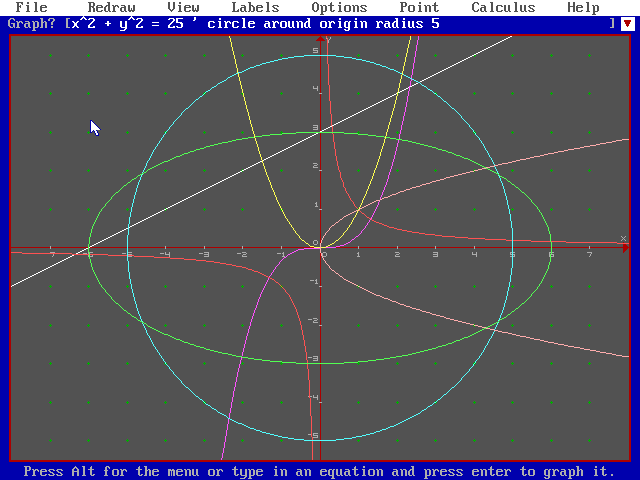 Graphmatica 3.60e for DOS
Graphmatica 3.60e for DOS

The DOS version runs on anything with DOS 3.0 or later. Even 8088
PCs with no hard drive and CGA graphics. (It's a little slow on one of these,
but isn't everything?) The entire program and online help files will fit on
one 360k floppy.
How to get your copy
Feature overview:
- The Redraw Queue. Graphmatica remembers the last 25 equations you
typed in or loaded from a file. You can save your work for use in a
later session or with any text editor or Graphmatica 1.6 for Windows.
- Automatic functions. Graphmatica will automatically
- determine the type of graph you are entering based on the
variables used,
- recognize an equation's domain if you include one,
- alter the sampling rate dynamically while graphing to make sure
steep graphs like y=tan x are tracked correctly,
- adjust the x/y ratio when you reset the range so proper aspect
ratio is maintained,
- redraw the most recently-entered equation(s) when you change the
size or shape of the grid by any means, and
- restore the grid and special options settings when you load an
equation list that has them.
You don't have to do anything to use these functions, but the
Options menu still gives you complete control over them.
- Advanced equation parser follows mathematical rules--not the
computer's. You can use implied multiplication, a complete library of
math functions (including trig), and even leave out those annoying
parentheses in appropriate places. Forget about isolating variables
before graphing! As long as there is only one instance of the
dependent variable in the equation, Graphmatica will isolate it for
you, and even graph relations. You also get the power of 6 styles of
graphing: regular Cartesian, polar, parametric, and slope-field and
initial-value approximations for up to fourth-order ODEs (and fourth-
order linear systems as well), all detected automatically. Cartesian
inequalities are supported as well.
- Convenient controls: the status bar displays relevant information
about the selected equation, and help or error messages, and the
Redraw Queue combobox lets you select any equation in memory
to graph, delete, or edit to form a new equation.
- Pause and Print tables options let you see the coordinates of points
on your graphs... as they are drawn. Print tables shows values at
whole-number intervals so you can practice sketching curves yourself.
- Convenient mouse-oriented operations. You can use the mouse to select
a new range or view the coordinates of a point, select the initial
value for an ODE, and even find the tangent line of a curve or
integrate a function without pressing a single key.
- Flexible graph paper. Choose between regular graph paper and paper
appropriate for trig, polar, and logarithmic functions, at four
levels of detail.
- Powerful symbolic and numerical calculus features. Find derivatives,
integrals, and critical points for any Cartesian function.
- Lots of output options. Graphmatica lets you export your graphs to a
standard PC-Paintbrush (.PCX) file for inclusion into other documents,
or print directly to any Epson-compatible dot-matrix or HP DeskJet,
LaserJet, or compatible inkjet or laser printer.
- Every automatic option is also user-settable to give you absolute
control over your graphs. And the Save Setup Info command lets you
save your preferences so they are automatically restored whenever you
run Graphmatica.
- Instructive help topics explain the basics of each type of graph,
online help lets you brush up on most features without exiting the
program, and included demo files show you examples of each form of
equation. See the section below for a list of these files.
Back to Graphmatica homepage...
kSoft, Inc. ksoft@graphmatica.com
Last updated: Mon 17 May 1999
